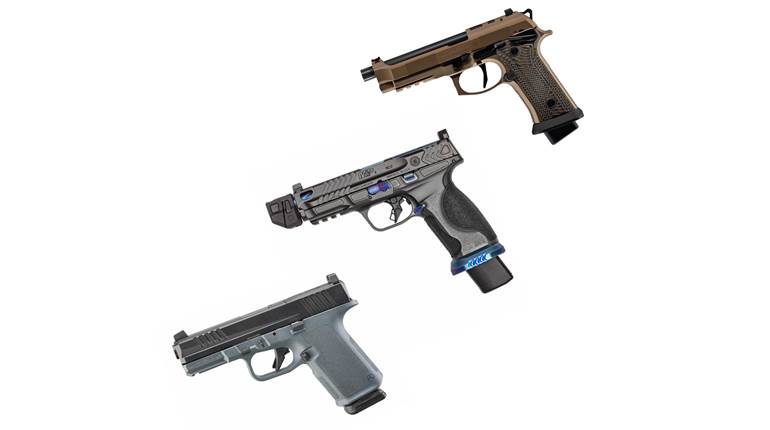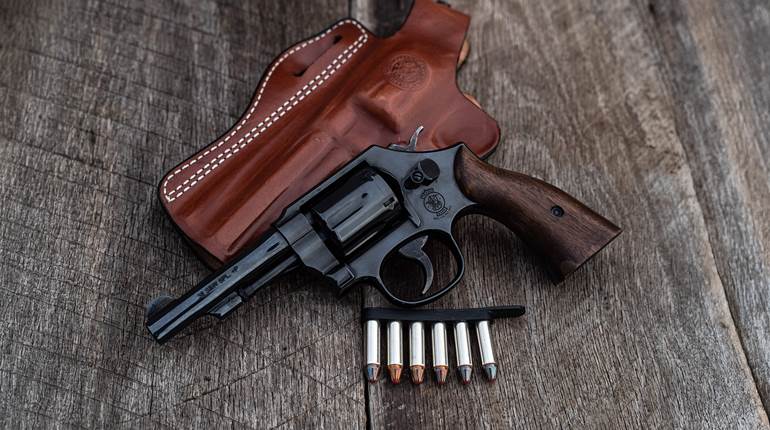
I may be dating myself to the detriment of my ongoing credibility, but I do remember the incident. No less of an authority than Maj. Gen. Julian Hatcher, editor of the prestigious American Rifleman, was commenting on a new product of a major American Arms maker. Colt Firearms had just introduced a completely new gun. As was the Colt custom, the gun was a six-shot revolver, but this one was fancy well beyond the norm. So much so that the good general wondered in print whether or not enough shooters would ever pony up $125 for a .357 Mag. revolver. 
4" barrel blued Colt Python
It was the mid 1950s and Colt had just announced a revolver they called the Python. That was better than 60 years ago and public acceptance of the big wheelgun has always been strong. As a matter of fact, General Hatcher would doubtless be completely dumbfounded at what he could get for a mint condition 1955 Python today. It might be as much as $5,000 to $6,000 and sure, a great deal of that differential is what has happened to our money in six decades. But a lot more is because the gun is a classic symbol of the best of old-time gunmaking. Mostly however, the astronomical price tags are a function of the fact that the supply of Pythons is finite. And they'll never make any more.
There was plenty to get excited about in 1955, as the Python was a hell of a nice revolver. The exotic name might have been questionable in the minds of traditional shooters, but it seems to me that it gave just the right touch of adventure in the outdoors. The name followed the Cobra, the very successful hideout revolver that was the first to use an aluminum frame. Essentially, the Cobra was a lighter version of the pre-war Detective Special. But the Python was not only a bigger gun, there was a bigger story behind it.
Just before the start of World War II, Smith & Wesson had scored a major coup with the first .357 Mag. known as the Pre-War Registered Magnum. Although Colt made .357s in the late 30s (Peacemakers and New Services), the Python was introduced to compete with a post-war version of the same S&W gun. (In '55, no one knew what S&W had in store for post-war shooters, but they found out in 1956—the .44 Magnum). Colt management wanted to offer a premium revolver with traditional, visual and practical appeal. In other words, the new Python had to look like a Colt, but with a new sort of updated aspect and it had to shoot as well as anything they had ever made.
Bullseye shooting was very popular in those days and many shooters used special custom revolvers from King's of San Francisco. These guns were usually medium-to-large frame Colt or S&Ws with longer barrels. They were fitted with precisely adjustable rear sights, ventilated ribs and their lockwork was tuned to perfection. For shooters who wanted a gun with a more forward point of balance, King also offered a weighted tube on the lower edge of the barrel. Originally, the idea was to mount a weight in such a way that it can be moved back and forth to stay at that “just right” point of balance. It worked rather well and was even used on the customized Colt Woodsman .22s. The major visual appeal to the King revolvers was used on the Python—the ventilated rib.
Initially, the Python came with a 6” barrel and weighed 43 ozs. The gun was instantly popular, but there was an almost immediate demand for a shorter version for police holster carry. The factory wasted no time in getting the four” ones in production. Snubbies (2 ½-inchers) came along a little later and Target .38s with impossibly long eight” barrels were sold in the waning years of Python popularity. And there is a handful of almost mystic 3” Pythons that command incredible prices in today's market. Most Pythons were polished and blued, but nickel plating was also popular. A couple of other rough service plating systems came along and a complete stainless steel Python pleased the growing range of fans at its introduction in 1983.

6" barrel Colt Python with blued (top) and nickel finishes
Everything about the big revolver was first class. It was polished and assembled by hand and if the action needed a few strokes of a stone, it got them. When the makers determined that the hollow, adjustable-weight barrel lug was not going to be a useful touch, it became solid. In any length, the Pythons had a comfortable, muzzle-heavy feel to them. Even with the hotter loads, there was serious weight to the gun and it did not beat you up with recoil. As pricey as they may have been, Pythons initially sold well and respectable numbers of the guns actually ended up in the basketweave holsters of the nation's police officers.
It was in the early 1970s that I began to pay attention to combat shooting in general and Pythons in particular. I had taken a job with the Sheriff's Department in Orange County, Calif., and even managed to geezer my way through their academy. As was the case with most of my fellow deputies, I used S&W revolvers. I grew familiar with the subtleties of that great S&W action and used guns of four different sizes—J, K, L and N. But I also paid attention to the Colts and fired them whenever I could. One of my academy buddies used a 4” Python and I ran over the PPC course with that one once in a while. Eventually, he decided to sell the gun and I was right there with the C-note that he needed. I knew that Dave had the Python come out of a suspicious holster one night and bounce across an asphalt parking lot. He was chasing somebody who richly needed to be chased. The big Colt landed right on the edge of one cylinder notch and it never locked up right—on that chamber—after that. The permanent and positive solution was a new cylinder, which I was saving to have done. It was safe to shoot, so I fired the gun a good bit before I could assemble sufficient bucks to have that accomplished. In the interim, the Python was stolen, along with seven or eight other nice shooters. My learning program with Colts was curtailed. That's too bad, as I was getting downright respectful of the Colt system.
2.5" barrel snub-nose Colt Python
Later on, I went into the writing business and got assignments that had me shooting Pythons from time to time. I always came away with respect for their accuracy and performance. As a police officer, I had been one of the fans of the so-called “Smython” revolver, which marries a Python barrel to a Smith K frame. This gives you Python accuracy and heft, plus the Smith action and reliability. A Python barrel cost $35 in those days and when it was mounted on a S&W action, the result was one damned fine PPC revolver. But time passed and most police agencies began to shift to high-capacity semi-automatic pistols. As police weapons, the revolver saw declining interest, even though Ruger's GP100 and S&W's L frames were the finest service revolvers ever made. Colt was running to catch up and never really did. Their DA revolvers were eventually all discontinued. Including that magnificent Colt Python.
The Colt Python revolver was made from 1955 'til 2006, about 51 years. It was a black day for Colt people when the maker was no longer able to offer this gun to the American shooter. This was a firearm that demanded too much time from experienced craftsmen, so much so that its own excellence drove it out of the marketplace. In order to thrive in today's mass-produced polymer world, a product has to enjoy a steady and continuing demand. Too many up and down spikes in sales send those who count beans into heart palpitations. But what has happened in the firearms second-market defies logic.
4" barrel Colt Python with stainless steel finish
Some unknown, but relatively small, number of the original 600,000-odd Pythons were never fired. A much larger number of the guns were fired sparingly and most were fired even more. It is rare to see a Python that is worn out, but you do see guns that have been used heavily. I saw one at the Big Reno Show last year that had been through the patrol wars—nicks, small dents and no finish left. The guy wanted $1,300 for it. An early gun, had it been unfired and mint, he could have probably realized three times that. The Colt Python is the hottest gun in circulation.
This unusual and intense demand for pristine specimens has carried over to six other revolvers made by Colt in the latter part of the 20th Century—Cobra, King Cobra, Diamondback, Boa, Viper and the massive Anaconda. An excellent recent book—Seven Serpents—chronicles the production history of the seven. It is, however, with the Python that the values are out of sight. The gun was made in several different barrel lengths and finish variations, as well as specially marked special editions and custom shop engraved. Everything that is done to a Python that makes it different from all others increases its value---as long as the differences are factory original and in good taste. Any new Python lists for at least several thousand dollars. As an example of how crazy this is getting, I recently watched a rare 3” barrel sell on an on-line auction for two grand—just the barrel—not the whole gun.
4" barrel Colt Python with nickel finish, circa 1975
In the pistolero's vernacular, these guns are safe queens. Colt made them to be fired in their owner's service, but shooting a mint or “minty” (whatever that means) Python at this point in time is stupid. It's just as dumb as lighting your cigar with a C-note. There must be tens of thousands of good used Pythons in circulation, but there aren't that many of them on the used gun shelf at your local gun store. I am guessing that guys who have one are keeping it to shoot and enjoy. They have doubtless concluded that they will never get another one. They won't.
We have a major contradiction going on here. Once we had writers hard at work extolling the virtues of the Python as a shooting tool and now they wonder about how much one of these is worth—if they say anything at all. I am a shooter and I want to shoot these grand old guns, not put on kid gloves to admire them once a month when the moon is full. I have discovered a way to create a revolver that has every meaningful shooting characteristic of the Colt Python. Look to the next posting of "Clapp on Handguns" and I'll explain it in detail. Then ... well, we'll just have to take them to the range ... .
IMFDB images
Additional Reading:
NRA Gun of the Week: Colt Python Revolver
A Look Back at the Colt Python






































